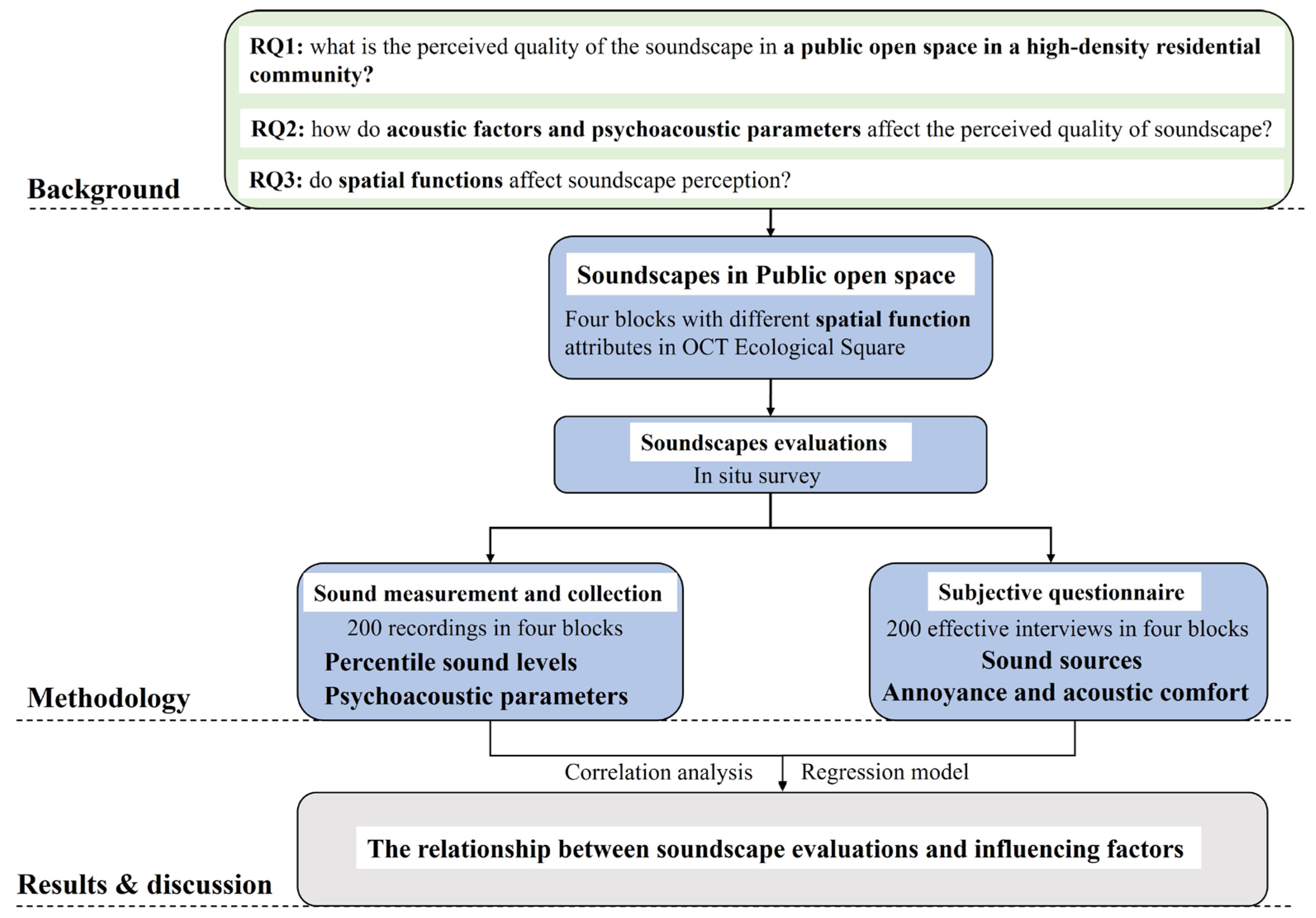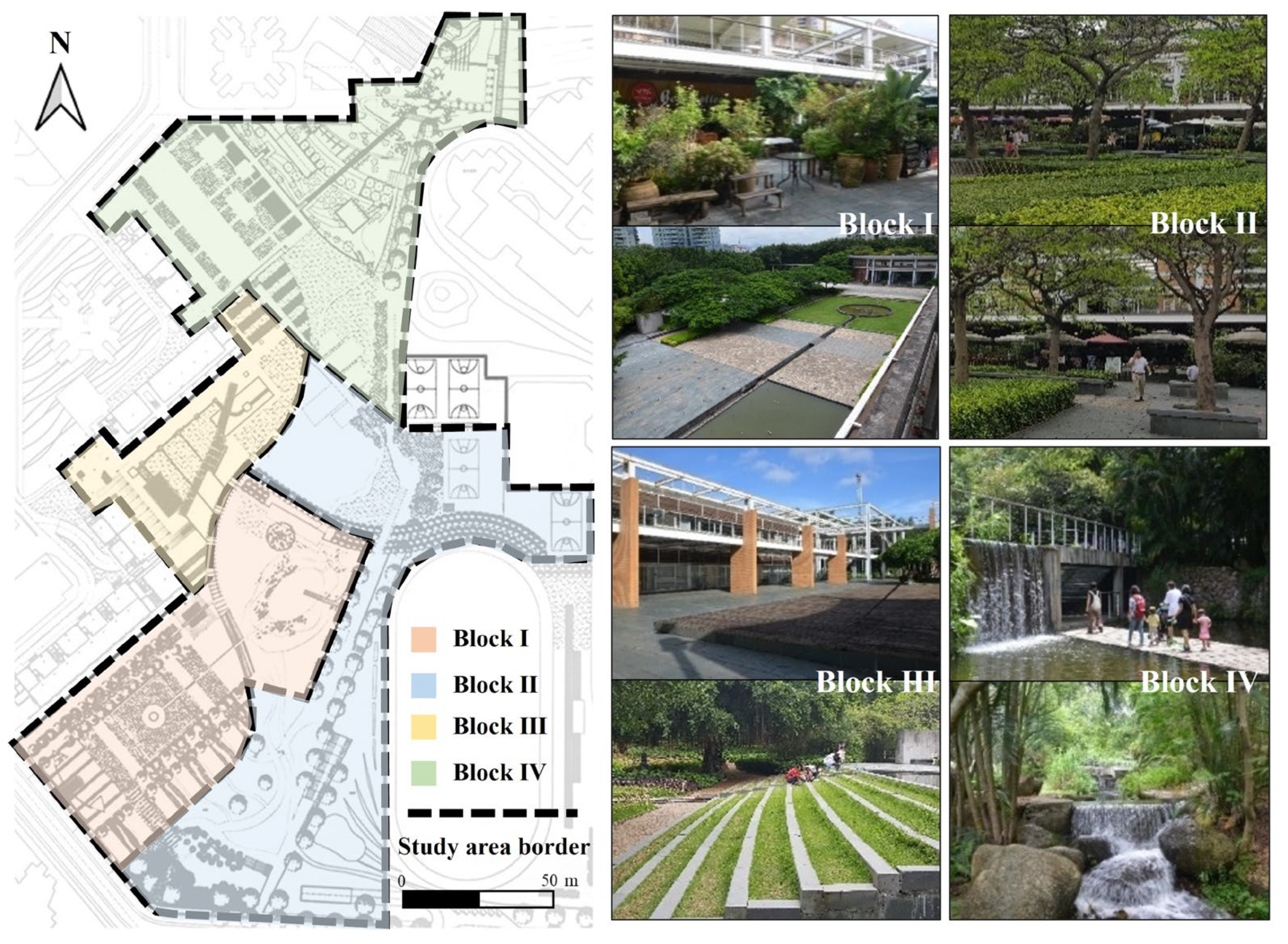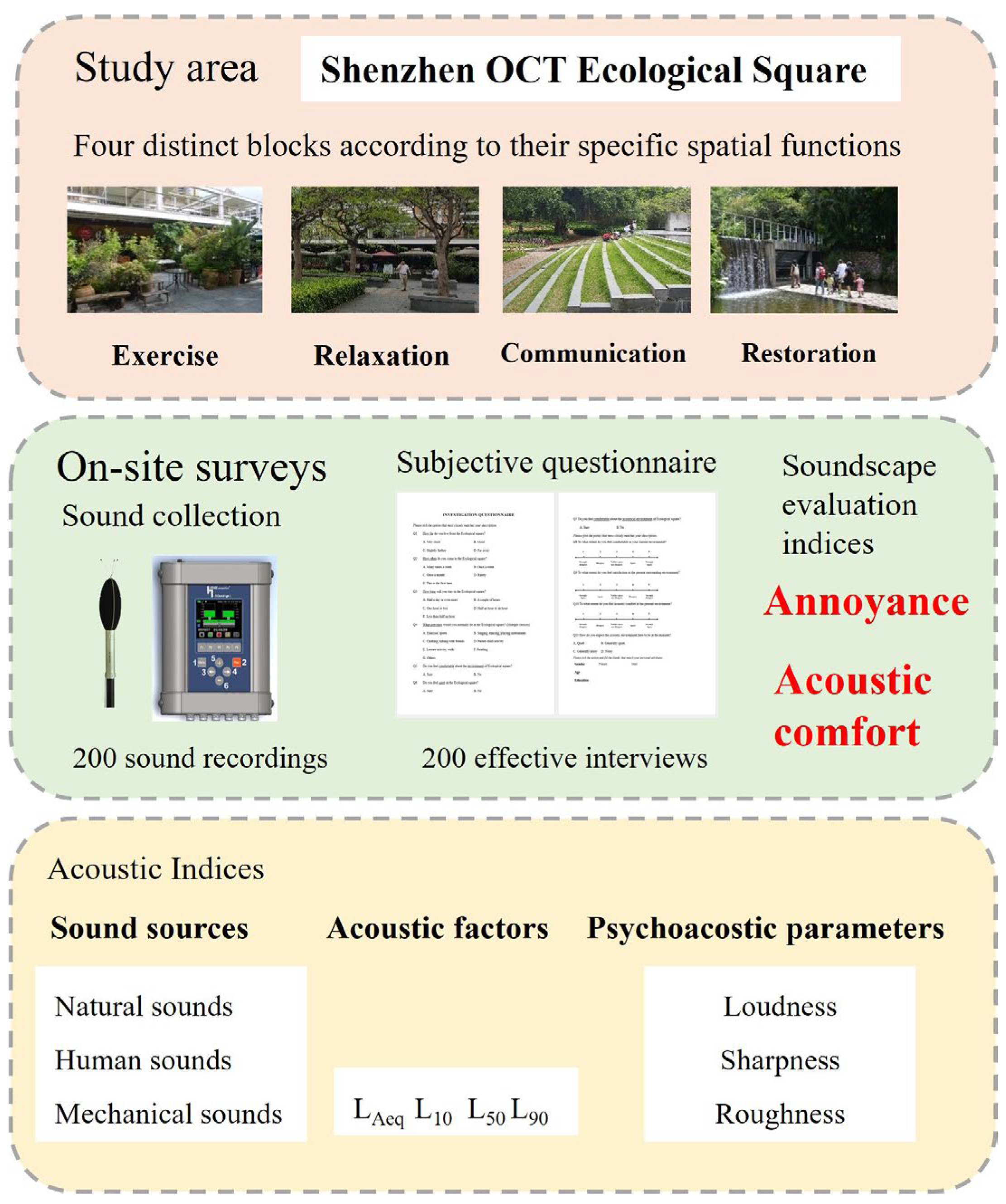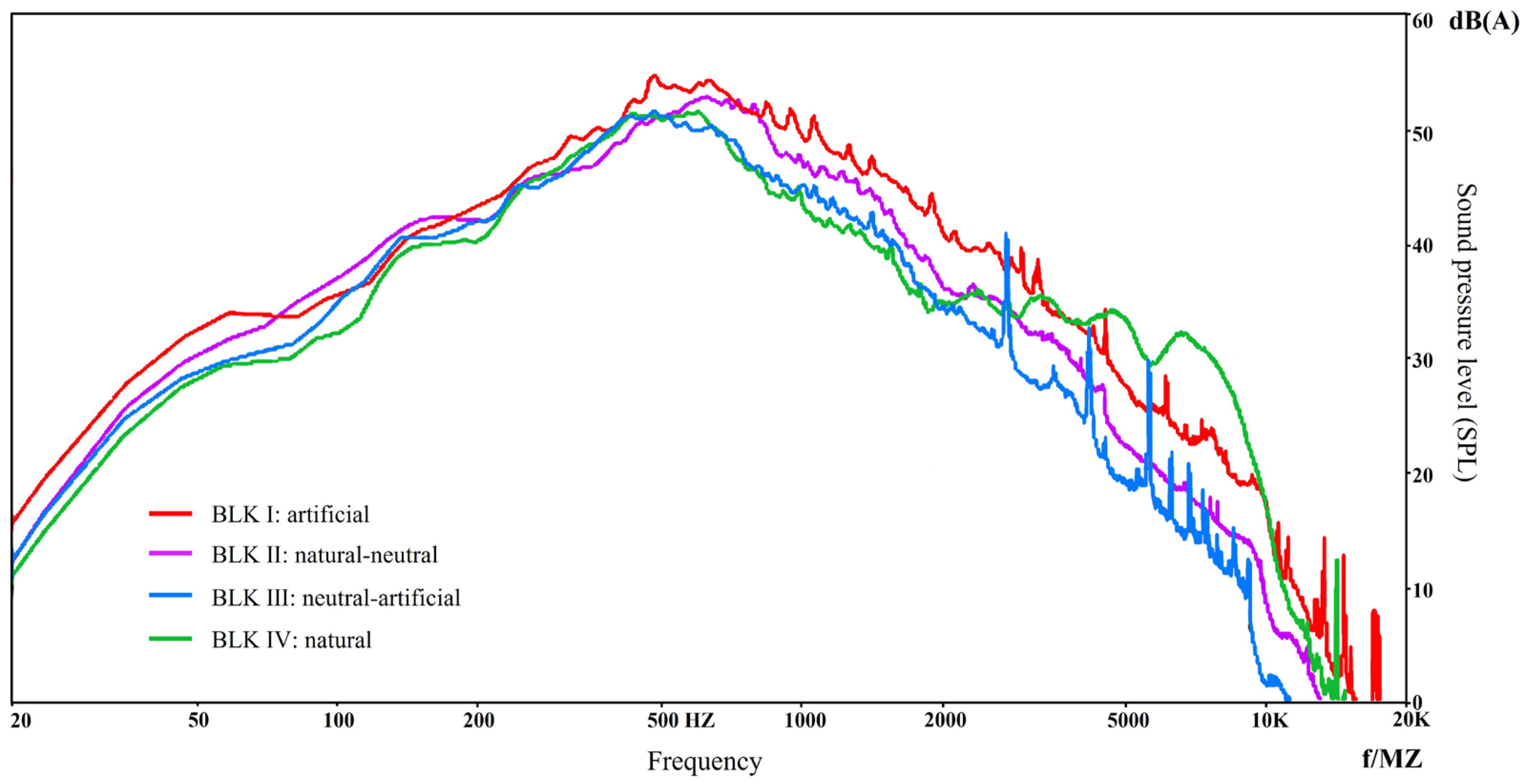Identification, Evaluation, and Influencing Factors of Soundscapes in Public Open Spaces in High-Density Residential Areas
Abstract
:1. Introduction
2. Materials and Methods
2.1. Location, Views, and Activities of the Study Site
2.2. Sound Collection
2.3. Survey Instrument
2.4. Indicator Processing Procedure
2.4.1. Sound Levels and Psychoacoustic Parameters
2.4.2. Statistical Approach
2.5. Soundscape Identification
3. Results
3.1. Interviewees
3.2. Sound Sources
3.3. Sound Levels
3.4. Spectrum
3.5. Psychoacoustic Parameters
4. Soundscape Evaluations and Influencing Factors
4.1. Subjective Evaluations
4.2. Influencing Factors
4.3. A Comparison among the Four Blocks
5. Conclusions and Perspectives
- (1)
- Soundscape identification is useful to preliminarily determine subjective evaluations of annoyance and acoustic comfort. Generally speaking, a place with a more natural soundscape is usually perceived to be less noisy and to provide more acoustic comfort but a place with a more artificial soundscape is not perceived to be noisier or to provide acoustic discomfort. This might be related to the spatial function, which has some influence.
- (2)
- For the acoustic comfort evaluations, it is interesting to note that the block with an artificial soundscape (BLK-I) was perceived to provide more acoustic comfort than the block with a neutral-to-natural soundscape (BLK-II), although the former was perceived to be noisier than the latter. This result implies that identifying a soundscape based solely on the in situ sound source and landscape observations may be reliable but imprecise.
- (3)
- For the blocks with more artificial soundscapes, higher sound levels resulted in better soundscape evaluations, whereas in the blocks with more natural soundscapes, higher sound levels resulted in worse soundscape evaluations. Such a conflict might be related to the place’s spatial function.
- (4)
- It is noteworthy that although acoustic factors have some influence on subjective evaluations, a non-acoustic factor, the spatial function, may have an influence that should be considered in a future study.
- (5)
- By researching soundscape identification, evaluations, and influencing factors, this study suggests that sound sources and landscapes are essential for determining the soundscapes in high-density residential open spaces. However, understanding the relationships between soundscapes and spatial functions is useful when evaluating a soundscape. In this study, analysis of the effects of spatial functions on soundscapes was performed qualitatively but not quantitatively. Therefore, further works will be required to investigate the spatial function and its relationships with other factors.
Supplementary Materials
Author Contributions
Funding
Institutional Review Board Statement
Informed Consent Statement
Data Availability Statement
Acknowledgments
Conflicts of Interest
References
- Liu, F.; Jiang, S.; Kang, J.; Wu, Y.; Yang, D.; Meng, Q.; Wang, C. On the Definition of Noise. Humanit. Soc. Sci. Commun. 2022, 9, 406. [Google Scholar] [CrossRef] [PubMed]
- Berglund, B.; Lindvall, T.; Schwela, D.H. Guidelines for Community Noise; World Health Organization: Geneva, Switzerland, 1999. [Google Scholar]
- Ecology Environment Bureau of Shenzhen Municipality. Report on the State of Shenzhen Ecology and Environment; Ecology Environment Bureau of Shenzhen Municipality: Shenzhen, China, 2023. [Google Scholar]
- ISO 12913-1: 2014; Acoustics-Soundscape-Part 1: Definition and Conceptual Framework. International Organization for Standardization: Geneva, Switzerland, 2014.
- Jo, H.I.; Jeon, J.Y. Urban Soundscape Categorization Based on Individual Recognition, Perception, and Assessment of Sound Environments. Landsc. Urban Plan. 2021, 216, 104241. [Google Scholar] [CrossRef]
- Li, M.; Han, R.; Xie, H.; Zhang, R.; Guo, H.; Zhang, Y.; Kang, J. Mandarin Chinese Translation of the ISO-12913 Soundscape Attributes to Investigate the Mechanism of Soundscape Perception in Urban Open Spaces. Appl. Acoust. 2023, 215, 109728. [Google Scholar] [CrossRef]
- Kang, J. Soundscape in City and Built Environment: Current Developments and Design Potentials. City Built Environ. 2023, 1, 1. [Google Scholar] [CrossRef]
- Gidlöf-Gunnarsson, A.; Öhrström, E. Noise and Well-Being in Urban Residential Environments: The Potential Role of Perceived Availability to Nearby Green Areas. Landsc. Urban Plan. 2007, 83, 115–126. [Google Scholar] [CrossRef]
- Langdon, F. Noise Nuisance Caused by Road Traffic in Residential Areas: Part I. J. Sound Vib. 1976, 47, 243–263. [Google Scholar] [CrossRef]
- Raimbault, M.; Dubois, D. Urban Soundscapes: Experiences and Knowledge. Cities 2005, 22, 339–350. [Google Scholar] [CrossRef]
- Hong, J.Y.; Jeon, J.Y. Influence of Urban Contexts on Soundscape Perceptions: A Structural Equation Modeling Approach. Landsc. Urban Plan. 2015, 141, 78–87. [Google Scholar] [CrossRef]
- Schulte-Fortkamp, B. The Meaning of Annoyance in Relation to the Quality of Acoustic Environments. Noise Health 2002, 4, 13–18. [Google Scholar] [PubMed]
- Nilsson, M.E.; Berglund, B. Soundscape Quality in Suburban Green Areas and City Parks. Acta Acust. United Acust. 2006, 92, 903–911. [Google Scholar]
- Schulte-Fortkamp, B.; Brooks, B.M.; Bray, W.R. Soundscape: An Approach to Rely on Human Perception and Expertise in the Post-Modern Community Noise Era. Acoust. Today 2007, 3, 7–15. [Google Scholar] [CrossRef]
- Schulte-Fortkamp, B.; Fiebig, A. Soundscape Analysis in a Residential Area: An Evaluation of Noise and People’s Mind. Acta Acust. United Acust. 2006, 92, 875–880. [Google Scholar]
- Niessen, M.E.; Van de Cruys, T.; Cance, C.; Dubois, D. Sound and Noise in Sonic Environmental Studies: Comparing Word Meaning in Discourses of Community Noise and Soundscape Research. Acta Acust. United Acust. 2013, 99, 853–862. [Google Scholar] [CrossRef]
- Yang, W.; Kang, J. Acoustic Comfort Evaluation in Urban Open Public Spaces. Appl. Acoust. 2005, 66, 211–229. [Google Scholar] [CrossRef]
- Yang, C.; Shi, S.; Runeson, G. Towards Sustainable Urban Communities: Investigating the Associations between Community Parks and Place Attachment in Master-Planned Estates in Sydney. Sustain. Cities Soc. 2023, 96, 104659. [Google Scholar] [CrossRef]
- Zhang, X.; Ba, M.; Kang, J.; Meng, Q. Effect of Soundscape Dimensions on Acoustic Comfort in Urban Open Public Spaces. Appl. Acoust. 2018, 133, 73–81. [Google Scholar] [CrossRef]
- Calleri, C.; Astolfi, A.; Armando, A.; Shtrepi, L. On the Ability to Correlate Perceived Sound to Urban Space Geometries. Sustain. Cities Soc. 2016, 27, 346–355. [Google Scholar] [CrossRef]
- Yong Jeon, J.; Jik Lee, P.; Young Hong, J.; Cabrera, D. Non-Auditory Factors Affecting Urban Soundscape Evaluation. J. Acoust. Soc. Am. 2011, 130, 3761–3770. [Google Scholar] [CrossRef] [PubMed]
- Yu, L.; Kang, J. Factors Influencing the Sound Preference in Urban Open Spaces. Appl. Acoust. 2010, 71, 622–633. [Google Scholar] [CrossRef]
- Yang, M.; Masullo, M. Combining Binaural Psychoacoustic Characteristics for Emotional Evaluations of Acoustic Environments. Appl. Acoust. 2023, 210, 109433. [Google Scholar] [CrossRef]
- Liu, J.; Kang, J.; Behm, H.; Luo, T. Effects of Landscape on Soundscape Perception: Soundwalks in City Parks. Landsc. Urban Plan. 2014, 123, 30–40. [Google Scholar] [CrossRef]
- Viollon, S.; Lavandier, C.; Drake, C. Influence of Visual Setting on Sound Ratings in an Urban Environment. Appl. Acoust. 2002, 63, 493–511. [Google Scholar] [CrossRef]
- Preis, A.; Kociński, J.; Hafke-Dys, H.; Wrzosek, M. Audio-Visual Interactions in Environment Assessment. Sci. Total Environ. 2015, 523, 191–200. [Google Scholar] [CrossRef] [PubMed]
- Brambilla, G.; Maffei, L. Perspective of the Soundscape Approach as a Tool for Urban Space Design. Noise Control Eng. J. 2010, 58, 532–539. [Google Scholar] [CrossRef]
- De Ridder, K.; Bruse, M.; Weber, C. BUGS—Benefits of Urban Green Spaces; EU Project 2001–2004: Final RESEARCHBRIEF. In Key Action City of Tomorrow and Cultural Heritage; Vito: Genk, Belgium, 2004. [Google Scholar]
- Nasution, A.D.; Zahrah, W. Quality of Life: Public Open Space Effects. Asian J. Environ.-Behav. Stud. 2018, 3, 124–132. [Google Scholar] [CrossRef]
- Lu, X.; Xie, Z.; Zhu, P.; Dai, X.; Zhang, Y.; Tao, W.; Wang, S. Comparative Evaluation of Soundscapes in Human Activities Spatial Contexts of Pedestrian Spaces Adjacent to Arterial Roads. Sci. Total Environ. 2024, 928, 172198. [Google Scholar] [CrossRef]
- Yang, W.; Kang, J. Soundscape and Sound Preferences in Urban Squares: A Case Study in Sheffield. J. Urban Des. 2005, 10, 61–80. [Google Scholar] [CrossRef]
- Meng, Q.; Kang, J. Effect of Sound-Related Activities on Human Behaviours and Acoustic Comfort in Urban Open Spaces. Sci. Total Environ. 2016, 573, 481–493. [Google Scholar] [CrossRef]
- ISO 12913-2: 2018; Acoustics-Soundscape Part 2: Data Collection and Reporting Requirements. International Organization for Standardization: Geneva, Switzerland, 2018.
- Kang, J.; Yang, W.; Zhang, M. Sound Environment and Acoustic Comfort in Urban Spaces. In Designing Open Spaces in the Urban Environment: A Bioclimatic Approach. Rediscovering the Urban Realm and Open Spaces-RUROS; Centre for Renewable Energy Sources, EESD, FP5: Athens, Greece, 2004; pp. 32–36. [Google Scholar]
- Axelsson, Ö.; Nilsson, M.E.; Berglund, B. A Principal Components Model of Soundscape Perception. J. Acoust. Soc. Am. 2010, 128, 2836–2846. [Google Scholar] [CrossRef]
- Cao, J.; Kang, J. The Influence of Companion Factors on Soundscape Evaluations in Urban Public Spaces. Sustain. Cities Soc. 2021, 69, 102860. [Google Scholar] [CrossRef]
- Jeon, J.Y.; Hong, J.Y. Classification of Urban Park Soundscapes through Perceptions of the Acoustical Environments. Landsc. Urban Plan. 2015, 141, 100–111. [Google Scholar] [CrossRef]
- Aletta, F.; Kang, J.; Axelsson, Ö. Soundscape Descriptors and a Conceptual Framework for Developing Predictive Soundscape Models. Landsc. Urban Plan. 2016, 149, 65–74. [Google Scholar] [CrossRef]
- Torresin, S.; Albatici, R.; Aletta, F.; Babich, F.; Oberman, T.; Stawinoga, A.E.; Kang, J. Indoor Soundscapes at Home during the COVID-19 Lockdown in London–Part I: Associations between the Perception of the Acoustic Environment, Occupantś Activity and Well-Being. Appl. Acoust. 2021, 183, 108305. [Google Scholar] [CrossRef]
- Cheng, J.; Chen, M.; Tang, S. Shenzhen–A Typical Benchmark of Chinese Rapid Urbanization Miracle. Cities 2023, 140, 104421. [Google Scholar] [CrossRef]
- Chen, Y.; Liu, T.; Xie, X.; Marušić, B.G. What Attracts People to Visit Community Open Spaces? A Case Study of the Overseas Chinese Town Community in Shenzhen, China. Int. J. Environ. Res. Public Health 2016, 13, 644. [Google Scholar] [CrossRef] [PubMed]
- Grinfeder, E.; Lorenzi, C.; Haupert, S.; Sueur, J. What Do We Mean by “Soundscape”? A Functional Description. Front. Ecol. Evol. 2022, 10, 894232. [Google Scholar] [CrossRef]
- HEAD Acoustics GmbH. Data Sheets for SQuadriga II. Available online: https://global.head-acoustics.com/downloads/eng/squadriga/D3320_SQuadriga_II_e.pdf (accessed on 11 November 2022).
- HEAD Acoustics GmbH. Psychoacoustic Analyses in ArtmiS II. Available online: https://www.head-acoustics.com/products/analysis-software (accessed on 11 November 2022).
- Kang, J.; Zhang, M. Semantic Differential Analysis of the Soundscape in Urban Open Public Spaces. Build. Environ. 2010, 45, 150–157. [Google Scholar] [CrossRef]
- Torija, A.J.; Ruiz, D.P.; Ramos-Ridao, A. Application of a Methodology for Categorizing and Differentiating Urban Soundscapes Using Acoustical Descriptors and Semantic-Differential Attributes. J. Acoust. Soc. Am. 2013, 134, 791–802. [Google Scholar] [CrossRef]
- Liu, J.; Kang, J. Soundscape Design in City Parks: Exploring the Relationships between Soundscape Composition Parameters and Physical and Psychoacoustic Parameters. J. Environ. Eng. Landsc. Manag. 2015, 23, 102–112. [Google Scholar] [CrossRef]
- Chen, H.-L.; Chen, C.-H.; Wu, C.-C.; Huang, H.-J.; Wang, T.-M.; Hsu, C.-C. The Influence of Neonatal Intensive Care Unit Design on Sound Level. Pediatr. Neonatol. 2009, 50, 270–274. [Google Scholar] [CrossRef]
- ISO 12913-3: 2019; Acoustics-Soundscape-Part 3: Data Analysis. International Organization for Standardization: Geneva, Switzerland, 2019.
- Sun, K.; De Coensel, B.; Filipan, K.; Aletta, F.; Van Renterghem, T.; De Pessemier, T.; Joseph, W.; Botteldooren, D. Classification of Soundscapes of Urban Public Open Spaces. Landsc. Urban Plan. 2019, 189, 139–155. [Google Scholar] [CrossRef]
- Abass, Z.; Tucker, R. White Picket Fences & Other Features of the Suburban Physical Environment: Correlates of Neighbourhood Attachment in 3 Australian Low-Density Suburbs. Landsc. Urban Plan. 2018, 170, 231–240. [Google Scholar]
- Lestari, W.; Sumabrata, J. The Influencing Factors on Place Attachment in Neighborhood of Kampung Melayu. In Proceedings of the IOP Conference Series: Earth and Environmental Science, Medan, Indonesia, 11–12 October 2017; IOP Publishing: Bristol, UK, 2018; Volume 126, p. 012190. [Google Scholar]
- Nemeth, E.; Pieretti, N.; Zollinger, S.A.; Geberzahn, N.; Partecke, J.; Miranda, A.C.; Brumm, H. Bird Song and Anthropogenic Noise: Vocal Constraints May Explain Why Birds Sing Higher-Frequency Songs in Cities. Proc. R. Soc. B Biol. Sci. 2013, 280, 20122798. [Google Scholar] [CrossRef] [PubMed]
- Halfwerk, W.; Slabbekoorn, H. A Behavioural Mechanism Explaining Noise-Dependent Frequency Use in Urban Birdsong. Anim. Behav. 2009, 78, 1301–1307. [Google Scholar] [CrossRef]
- ISO 532-1; Acoustics-Methods for Calculating Loudness-Part 1: Zwicker Method. International Organization for Standardization: Geneva, Switzerland, 2017.
- Aures, W. Berechnungsverfahren Für Den Sensorischen Wohlklang Beliebiger Schallsignale. Acta Acust. United Acust. 1985, 59, 130–141. [Google Scholar]
- Becker, J.; Sottek, R.; Lobato, T. Progress in Tonality Calculation. In Proceedings of the 23rd International Congress on Acoustics, Aachen, Germany, 9–13 September 2019; Universitätsbibliothek der RWTH Aachen: Aachen, Germany, 2019. [Google Scholar]
- Yu, L.; Kang, J. Effects of Social, Demographical and Behavioral Factors on the Sound Level Evaluation in Urban Open Spaces. J. Acoust. Soc. Am. 2008, 123, 772–783. [Google Scholar] [CrossRef] [PubMed]
- Aletta, F.; Lepore, F.; Kostara-Konstantinou, E.; Kang, J.; Astolfi, A. An Experimental Study on the Influence of Soundscapes on People’s Behaviour in an Open Public Space. Appl. Sci. 2016, 6, 276. [Google Scholar] [CrossRef]
- De Coensel, B.; Botteldooren, D.; De Muer, T.; Berglund, B.; Nilsson, M.E.; Lercher, P. A Model for the Perception of Environmental Sound Based on Notice-Events. J. Acoust. Soc. Am. 2009, 126, 656–665. [Google Scholar] [CrossRef] [PubMed]
- Hong, J.-Y.; Chong, K.H. Designing Public Soundscapes through Social Architecture and Soundscape Approaches: Reflective Review of Architectural Design Studio. Sustainability 2023, 15, 12399. [Google Scholar] [CrossRef]
- Deng, L.; Kang, J.; Zhao, W.; Jambrošić, K. Cross-National Comparison of Soundscape in Urban Public Open Spaces between China and Croatia. Appl. Sci. 2020, 10, 960. [Google Scholar] [CrossRef]





| Social/Demographic Background | Features | Composition Profile |
|---|---|---|
| Education level | Higher education | 77% |
| Elementary education | 23% | |
| Living distance | Close distance | 64% |
| Others | 36% | |
| Use frequency | Often | 78% |
| Others | 22% | |
| Occupation | Working people | 59% |
| Others | 41% |
| Sound Type | BLK-I | BLK-II | BLK-III | BLK-IV |
|---|---|---|---|---|
| Natural sounds | 21% | 41% | 38% | 60% |
| Human sounds | 41% | 44% | 39% | 23% |
| Mechanical sounds | 38% | 15% | 23% | 17% |
| Identified Soundscape | Artificial | Neutral–Natural | Neutral–Artificial | Natural |
| Variables | BLK-I | BLK-II | BLK-III | BLK-IV | ANOVA | ||
|---|---|---|---|---|---|---|---|
| Identified Soundscape | Artificial | Neutral–Natural | Neutral–Artificial | Natural | F | p | |
| Sound levels | LAeq (dBA) | 66.8 | 64.3 | 64.0 | 64.2 | 3.28 | 0.02 |
| L50 (dBA) | 63.6 | 57.7 | 57.7 | 58.1 | 16.95 | 0.00 | |
| L90 (dBA) | 59.0 | 53.4 | 53.3 | 53.2 | 25.22 | 0.00 | |
| L10 (dBA) | 69.4 | 66.5 | 67.0 | 66.7 | 2.78 | 0.04 | |
| Psychoacoustic parameters | Loudness | 14.89 | 10.86 | 10.43 | 11.6 | 14.17 | 0.00 |
| Sharpness | 2.30 | 2.26 | 2.09 | 2.6 | 14.96 | 0.00 | |
| Roughness | 1.88 | 1.67 | 1.70 | 1.6 | 4.45 | 0.00 | |
| Spatial Function | Exercise | Relaxation | Communication | Restoration | |||
| Variables | BLK-I | BLK-II | BLK-III | BLK-IV | ANOVA | |
|---|---|---|---|---|---|---|
| Identified Soundscape | Artificial | Neutral–Natural | Neutral–Artificial | Natural | F | p |
| Annoyance evaluation | 3.46 | 3.62 | 3.42 | 3.80 | 1.831 | 0.14 |
| Acoustic comfort evaluation | 3.78 | 3.64 | 3.54 | 3.92 | 2.316 | 0.08 |
| Factors | BLK-I | BLK-II | BLK-III | BLK-IV | |||||
|---|---|---|---|---|---|---|---|---|---|
| Annoy. | Acos. Comf. | Annoy. | Acos. Comf. | Annoy. | Acos. Comf. | Annoy. | Acos. Comf. | ||
| Sound Source | Natural Sound (%) | 0.08 | 0.20 | 0.16 | 0.33 * | 0.08 | 0.09 | −0.18 | 0.04 |
| Human Sound (%) | −0.01 | −0.10 | 0.03 | −0.11 | 0.11 | 0.12 | 0.37 * | 0.13 | |
| Mechanical Sound (%) | −0.03 | −0.03 | −0.21 | −0.25 | −0.24 | −0.27 | −0.13 | −0.16 | |
| Sound Level | LAeq (dBA) | −0.02 | 0.11 | −0.04 | −0.05 | 0.29 * | 0.09 | −0.30 * | −0.18 |
| L90 (dBA) | 0.01 | 0.03 | −0.11 | −0.22 | 0.20 | 0.17 | −0.29 * | −0.24 | |
| L50 (dBA) | −0.04 | 0.06 | −0.09 | −0.15 | 0.32 * | 0.19 | −0.31 * | −0.21 | |
| L10 (dBA) | −0.04 | 0.11 | −0.09 | −0.08 | 0.31 * | 0.11 | −0.29 * | −0.17 | |
| Psychoacoustic Indices | Loudness (sone) | −0.10 | 0.03 | −0.11 | −0.16 | 0.23 | 0.10 | −0.29 * | −0.20 |
| Sharpness (acum) | −0.06 | 0.02 | −0.06 | −0.14 | 0.00 | −0.19 | −0.14 | −0.15 | |
| Roughness (asper) | −0.12 | −0.04 | 0.05 | −0.04 | 0.14 | 0.14 | −0.19 | −0.10 | |
| Spatial function | Exercise | Relaxation | Communication | Restoration | |||||
| Identified Soundscape | Artificial | Neutral–Natural | Neutral–Artificial | Natural | |||||
Disclaimer/Publisher’s Note: The statements, opinions and data contained in all publications are solely those of the individual author(s) and contributor(s) and not of MDPI and/or the editor(s). MDPI and/or the editor(s) disclaim responsibility for any injury to people or property resulting from any ideas, methods, instructions or products referred to in the content. |
© 2024 by the authors. Licensee MDPI, Basel, Switzerland. This article is an open access article distributed under the terms and conditions of the Creative Commons Attribution (CC BY) license (https://creativecommons.org/licenses/by/4.0/).
Share and Cite
Xu, Z.; Yang, M.; Yu, L. Identification, Evaluation, and Influencing Factors of Soundscapes in Public Open Spaces in High-Density Residential Areas. Appl. Sci. 2024, 14, 6946. https://doi.org/10.3390/app14166946
Xu Z, Yang M, Yu L. Identification, Evaluation, and Influencing Factors of Soundscapes in Public Open Spaces in High-Density Residential Areas. Applied Sciences. 2024; 14(16):6946. https://doi.org/10.3390/app14166946
Chicago/Turabian StyleXu, Zeyu, Ming Yang, and Lei Yu. 2024. "Identification, Evaluation, and Influencing Factors of Soundscapes in Public Open Spaces in High-Density Residential Areas" Applied Sciences 14, no. 16: 6946. https://doi.org/10.3390/app14166946




